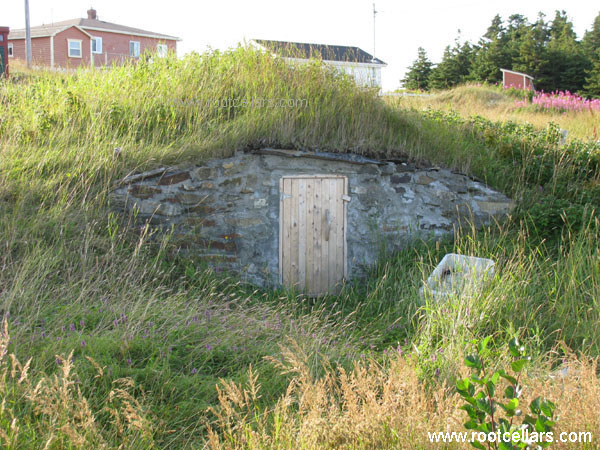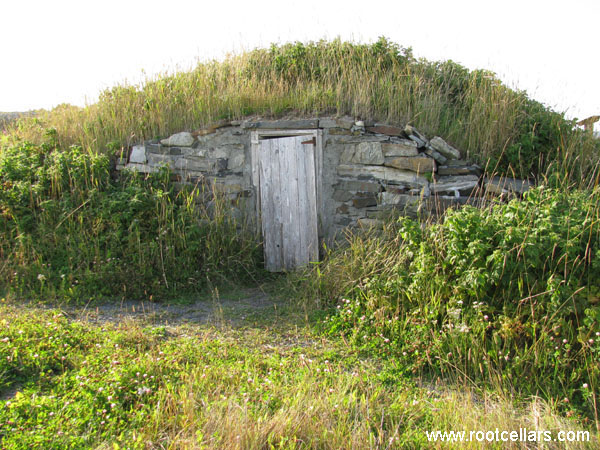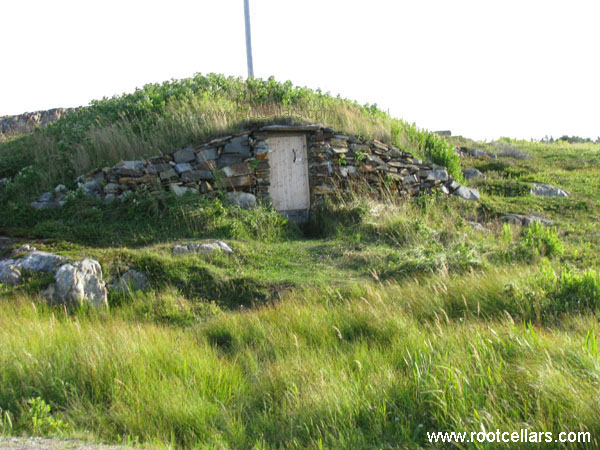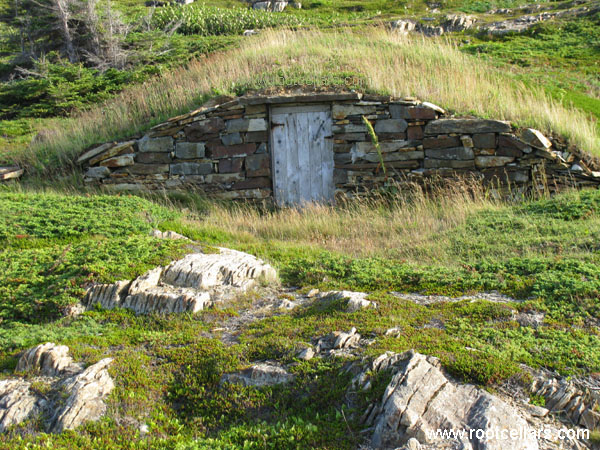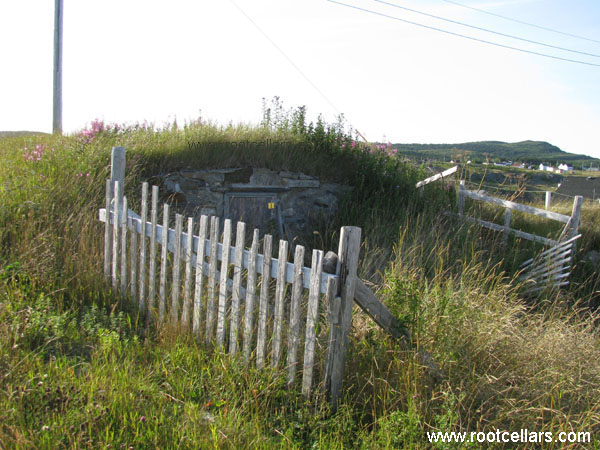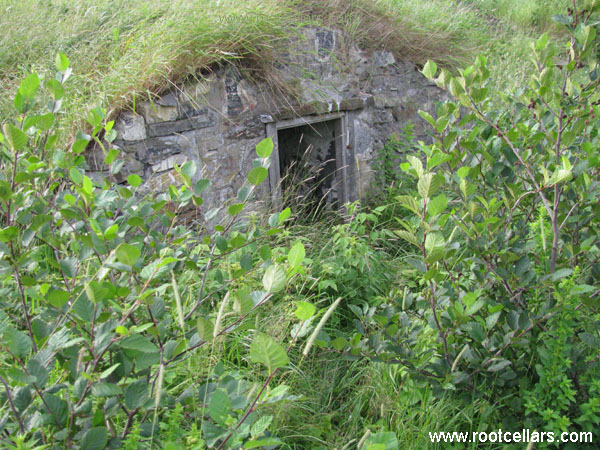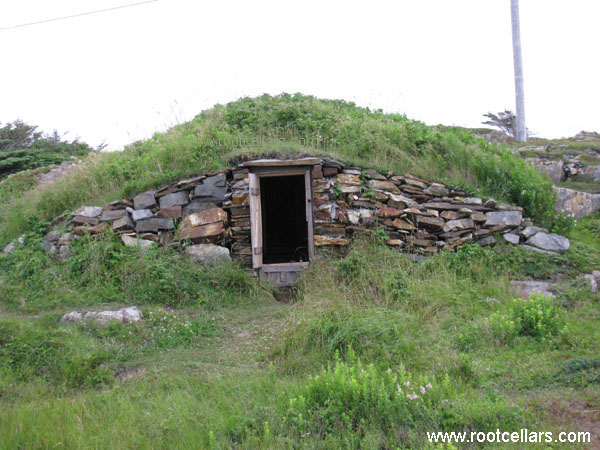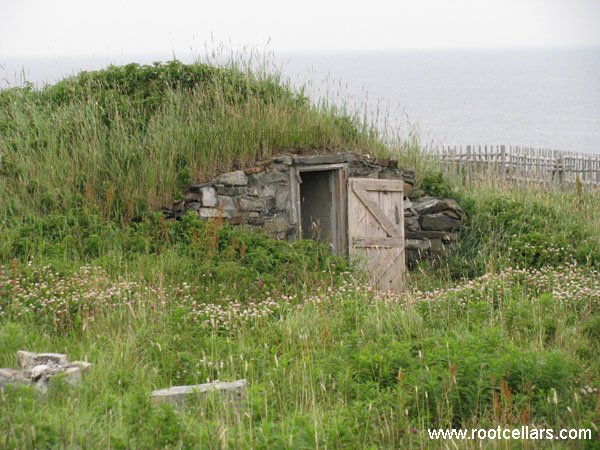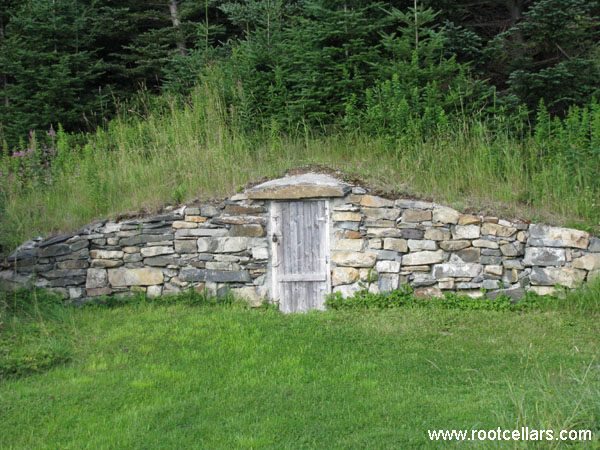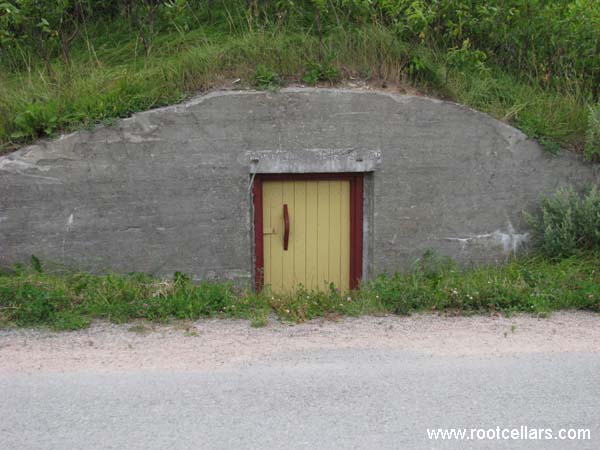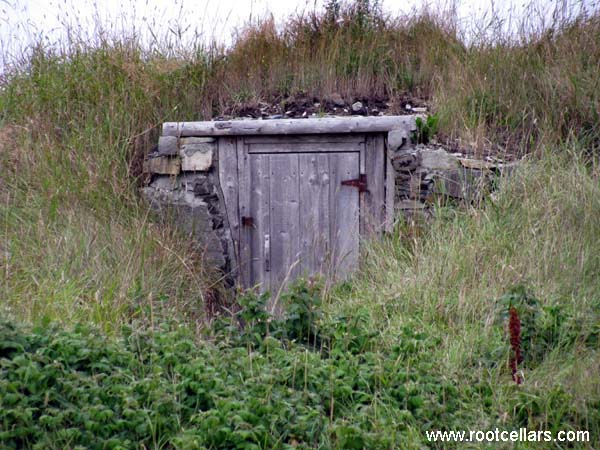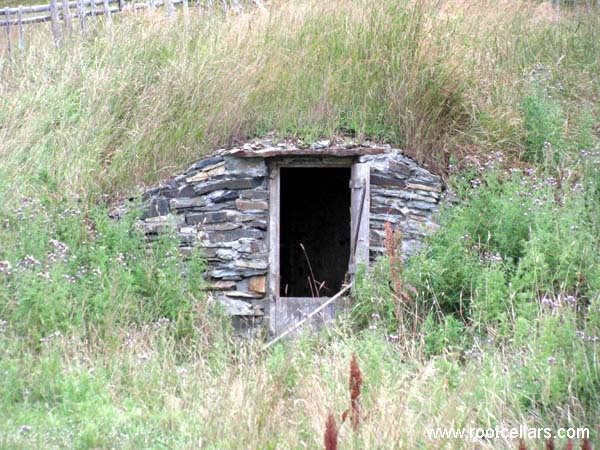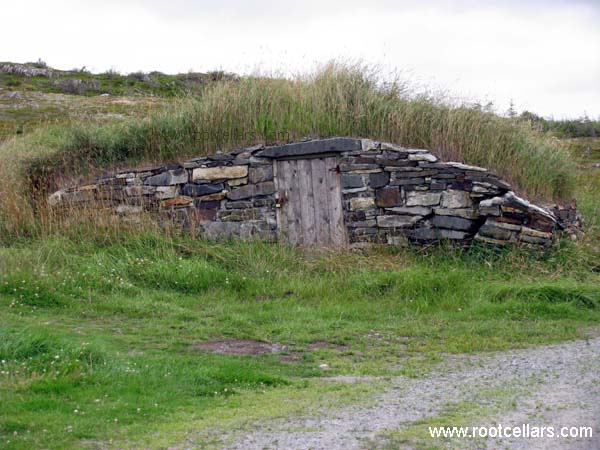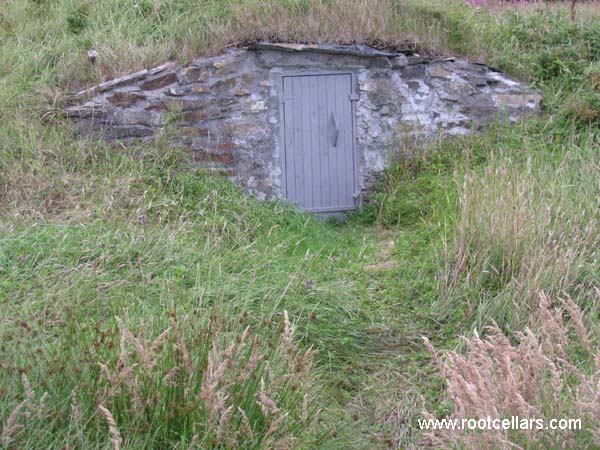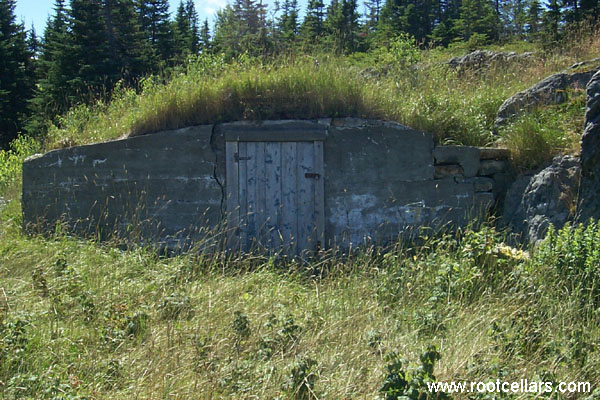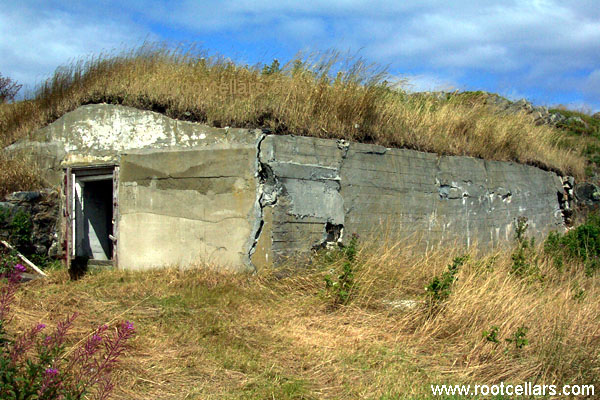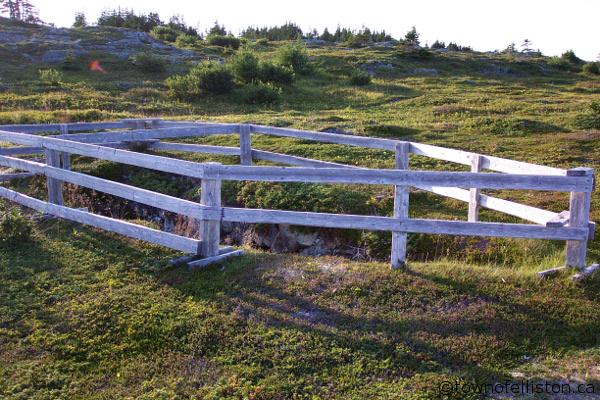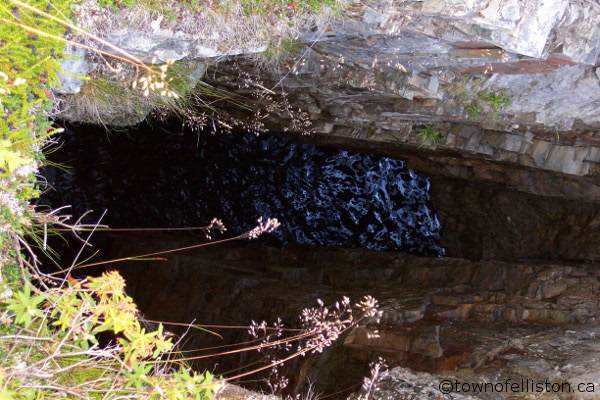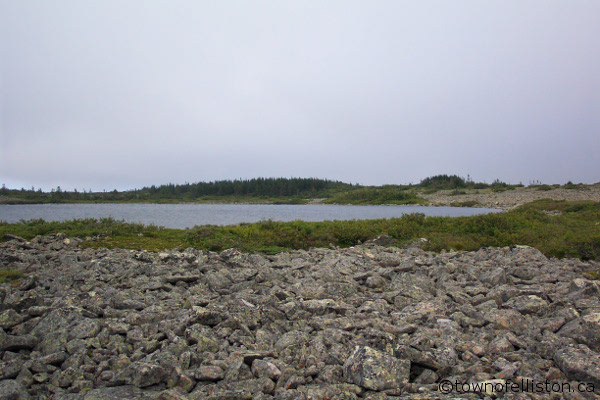
|
Visitor Information - Menu

VISITOR INFORMATION - Geopark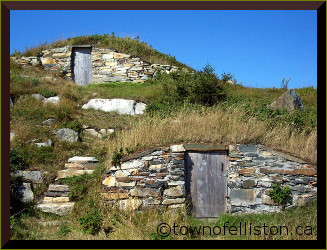
A Geopark is an area recognized by the Global Geopark Network to have exceptional geological heritage. The Elliston area is part of the Discovery Geopark that takes in much of the Bonavista Peninsula. Some local attractions of a geological nature include Root Cellars, Mini-Dungeon and Felsenmeer.
Root Cellars
Elliston has been recognized for the root cellar that was the initial item that put Elliston on the map. A root cellar is a free-standing structure built above ground, or wholly or partly buried in the ground. They are used for storing vegetables over the winter. While root cellars are not unique to this province, they are especially prevalent on the Island. The little doors in hillsides are a familiar sight. A well-maintained root cellar kept a crop of summer root vegetables from freezing or rotting over the winter. They were therefore a crucial part of the subsistence lifestyle that allowed fishing families to settle along this province’s rugged coastline. Root Cellars were designated, in 2013, as a Distinctive Cultural Tradition and Practice.
Elliston declared itself the "Root Cellar Capital of the World" in July 2000. We had 133 documented root cellars, some of which have survived nearly two centuries. Unfortunately, a few have been destroyed in recent years with new construction or renovations to private property, so the true number is somewhat less. Nevertheless, Elliston remains a cultural center for those who seek to gain an understanding of early Newfoundland subsistence. On October 13th, 2013 root cellars were recognized as a distinct cultural tradition/practice by the Provincial Historic Commemorations Program.
A root cellar is a structure that was built in the days before electricity in order to keep vegetables from freezing in the winter months and to keep its contents cool during the warm summer months. However, they provided for more than just a place for storage of various items. Root cellars were also incorporated into the fun past times of the children. Boys and girls use to gather around the cellars and have all kinds of games. When the boys and girls would go out in the evenings, the boys would make use of the various cellars to scare the girls. Others believed there were spirits in the root cellars. The young boys would jump out and scare the young girls!
Folklore was associated with the root cellars as well. A common local story was that of parents informing their children that babies came from the root cellars. Children from the Maberly-Neck section of Elliston were told that babies came from John Murphy's cellar. It is possible that the story of babies coming from root cellars can be traced back to the United Kingdom. In Wales, parents would tell their children that Leprechauns lived in the cellars, and that these Leprechauns would sometimes kidnap a farmer's wife in order to help her deliver her baby.
The root cellar played an important role in the life of the people of Elliston and surrounding areas. This role was not only in the preservation of vegetables and other food supplies, but also in the games that were played by the children, and the stories of folklore that were passed down through the generations.
The Root Cellars of Elliston, Newfoundland and Labrador
Below is a short poem that nicely sums up a root cellar's function.
Root Cellar A dark and dismal place Its origins lost in history
Frequently Asked Root Cellar Questions
What is a root cellar? 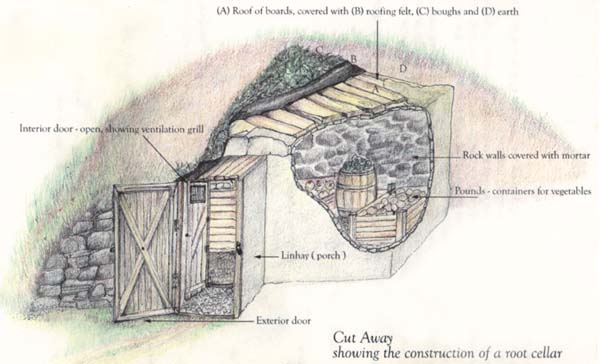
A root cellar can be described as a structure that was built in the days before electricity in order to keep vegetables from freezing in the winter months and to keep it contents cool during the warm summer months. Elliston first received electrical power in the main part of town in the 1920's, but the Maberly area did not have this service until the 1960's. However, even after people began using electric refrigerators, the root cellars were still used by some families.
How old are Elliston's root cellars? The oldest surviving cellars date back to 1839, being originally owned/built by George Porter, a second by Israel Baker, and a third by Abel Crewe. A root cellar that was built around 1839, and located in the Maberly area, is still in use today, and is in quite good condition. The newer root cellars are at least 60 or so years old, having been built in the 1950's.
How were root cellars constructed? There were three basic ways in which a cellar could be built: by digging a hole in the ground, from the ground up, by digging out of a hill or against a cliff. The most noticeable type of root cellar that can be seen in Elliston is the kind that is built into a hill.
Type I: Hatch Cellar The first way was by digging down into the ground. Usually this involved a cellar underground with a shed built over it. This type of cellar was convenient in that you could go into it by using a trap door in the shed that was built over the root cellar.
Type II: Ground Up Cellar Many people built a cellar this way mainly because they didn't have a hill on their land, and they didn't want a cellar/shed type of root cellar. The cellar was mainly built up from the ground using what seems like a wooden structure. Rock was then used, with sods put over the top and sides of the root cellar. Some of the advantages of building this type of cellar were that it was easier to excavate, and it was easier and cheaper to build.
Type III: Hill Side Cellar This type began by digging a hole out of the side of a hill or against a cliff. The cellar was ordinarily a cave hollowed into the side of a hill with outer walls of rock. The roof was a wooden framework covered with sods. The main advantage to building the root cellar in this way was that water that should seep would run out the door.
What materials were used to build root cellars? At the time most root cellars were built many modern materials were not available. The older cellars were built using rocks, wood, mortar (cement), and sods. The newer ones, from the 1920's on, are mostly made out of concrete with sods put on top. The doors were mainly of wooden construction.
Were all the root cellars built using the same materials? For the most part they were but not always. For example, the root cellar built in 1879 by Tom Porter. If you look inside, you can see a steel beam that is put into the roof of the cellar. The steel beam is from the shipwreck of the "Eric." This shipwreck occurred near Flowers Cove (a cove located near Maberly) in the 1870s. It took two days to bring the beam from Maberly to Elliston with a horse and cart.
What tools were used? Most of the root cellars located in Elliston were built in a time where most of today's modern tools were not available. The men did not have power saws or cement mixers. The tools that they did have were basic ones such as picks, shovels and crowbars. Wheelbarrows were used to move the rocks and sods. Other tools used by a few of the men were mauls (7 to 10 pounds), block and tackle, and wooden levels.
Where did root cellars come from? No one exactly knows where the idea of building root cellars originated. The first settlers to Elliston (Bird Island Cove) had ties that can be traced back to England, and what was once known as the "West Country." It is also believed that a small number of settlers to this area came from Ireland. Although it can be assumed that the technology of the root cellar was introduced into this area by these settlers, one cannot say with absolute certainty that this was the case.
When were root cellars constructed? Short answer = When time permitted. The men would only have time to build a root cellar when they weren't busy fishing or cutting wood. Most fishing was done from late spring until late in the fall, and most of the wood was cut during the fall and winter. So, the early spring was really the only opportunity to build a root cellar. It would take about a month for one man to build a cellar. Only one to two weeks if four or five men worked on it. Older men recommended that the root cellar doors, if possible, should face the east. The reason for this is that easterly winds were believed to be generally frost free.
Why use a root cellar? There were two main reasons why the citizens of this community used root cellars in the past: to keep food supplies from freezing during the winter months and to keep food supplies cool during the summer months. Typically, families would put a variety of vegetables in the root cellar in the fall of the year, after the harvesting of the vegetable gardens had been completed. The main vegetables stored in the root cellar consisted of potatoes, turnip, and carrot. Although some people did store cabbage in the root cellar, it would appear that most did not as cabbage had a tendency to rot if not pickled first. Other food supplies placed in the root cellar over the winter months included beets, preserves/jams, salt meat, salt turbot, and salt herring.
Food supplies were kept in the root cellar in the summer months to avoid spoilage. Water, bread, butter, milk, and cream were stored in the typical root cellar so that these items could be used more than once by the family. In addition, items such as salads, fresh meat, and jam pies were kept in the root cellar early in the day, so that they could keep cool until they were needed for supper.
Another important reason to use a root cellar was the unavailability of electric refrigeration to the community in the 1800's and early 1900's. The root cellar was essential to the people living in Elliston from the time of settlement up until the time when electricity first came to the community. Elliston first received electrical power in the main part of town in the 1920's and the Maberly area in the 1960's.
What else did people use root cellars for? A secondary use for the root cellar seems to be as a place in which to store alcoholic beverages. The men of Elliston apparently used the root cellar as a place in which to keep their homemade wine and beer. Indeed, many local men made reference to using the root cellar as an ideal place in which to brew their alcoholic spirits.
When was a reference to Elliston root cellars first made? The first reference found in print about Elliston’s root cellars was in 1846 with a reference that “. . . potatoes . . . are generally sown in the month of May and the beginning of June, and are dug up and deposited in the cellars, from the winter frost, in October.” While the number of cellars during this early time is unknown, this does suggest that many more once existed in this area.
Were root cellars considered oddities? Not at all. Root cellars were a part of life in this area. Up until the mid-1900's it was rather difficult to purchase vegetables in this area. This meant that most, if not all, citizens of this community had a vegetable garden. One can imagine men and women digging up their gardens in the fall of the year, and with help from their children, putting the vegetables in a root cellar that was probably located not too far from where they resided. Root cellars were not considered to be oddities, but quite the opposite, were essential to the subsistence of this and many other areas of this province.
Some Local Root Cellars

Mini-Dungeon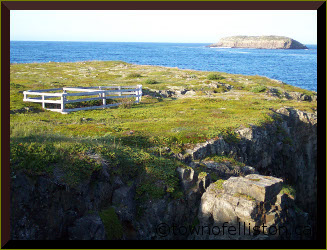
Elliston has what many people may describe as a Mini-Dungeon (aka Blow Hole) located not too far from Sandy Cove. This hollow in the ground was caused through the process of erosion over many years and is similar to Bonavista's Dungeon but on a smaller scale.
It is fenced off but caution is advised about getting too close.
Mini-Dungeon PhotosHere are some photos of from the Elliston area. Click to enlarge.

Felsenmeer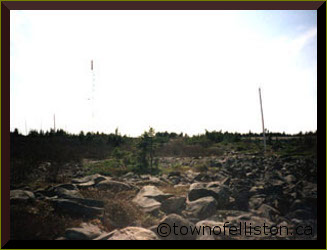
Note:
Felsenmeer n. (German) "sea of rocks" or "boulder sea": chaotic, block-like assemblage of fractured rocks or rock surfaces.
Nunatak n. (Inuktitut)
"free of ice": an unglaciated area.
Elliston boasts a geological feature that is quite rare in this area. It is believed that Elliston Ridge (Burnt Ridge) during the last ice age remained un-glaciated (i.e., nunatak), which is rather unusual at such a low elevation.
This un-glaciated area led to the formation of Felsenmeer, which is essentially exposed rock surfaces that have been broken up by frost action so that much rock is buried under a cover of angular shattered boulders. This principally occurs in Arctic regions and high mountain areas. Their continuity and depth vary with climate, vegetation and rock type.
In Newfoundland there are only a few occurrences of Felsenmeer. One is in the high plateaus of western Newfoundland and the other is on the highlands east of the Goulds. Elliston's Felsenmeer unlike many other examples is readily accessible by foot at a much lower elevation on the Mark's Path and Elliston Ridge trails.
Here are some photos of from the Elliston area. Click to enlarge.
| Back to Top | | |||||||||||||||||||||||||||||||||||||||||||||||||||||||||||||||||
Elliston Community Website www.townofelliston.ca by NKT
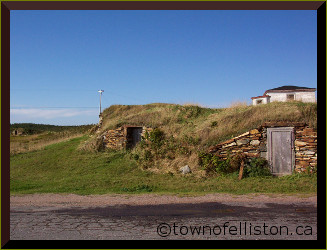 There is hardly any trace
Forever it will remain a mystery.
The root cellar in summer
Keeps its contents cool
You do not need a hammer
Or any other sort of tool.
It remains somewhat warm
Even in the cold of winter
A root cellar is true to form
Whenever you choose to enter.
There is hardly any trace
Forever it will remain a mystery.
The root cellar in summer
Keeps its contents cool
You do not need a hammer
Or any other sort of tool.
It remains somewhat warm
Even in the cold of winter
A root cellar is true to form
Whenever you choose to enter.
